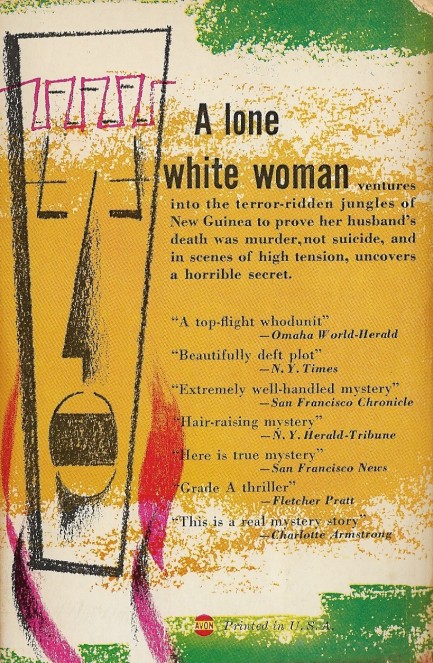| Vintage Pulp | Aug 21 2018 |

What does the cover have to do with the story? Virtually nothing.
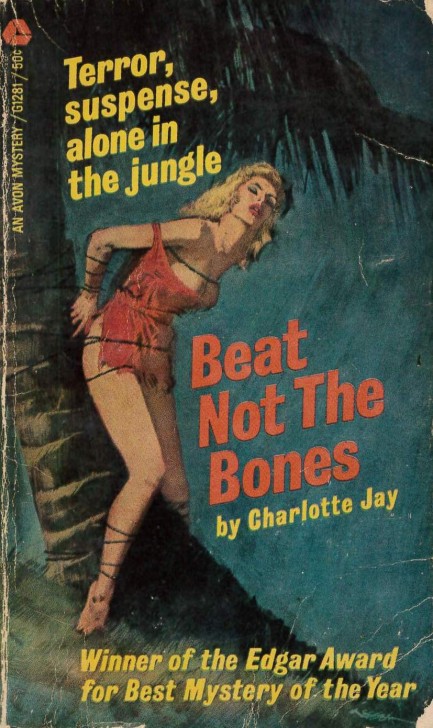
We showed you a 1955 Avon Publications cover for Charlotte Jay's award winning thriller Beat Not the Bones, and above you see an alternate cover from Avon that came in 1966. We don't remember the main character ever being tied to a tree, and we're sure she certainly never wore the sexy rag you see here, but those are the vagaries of good girl art. Both the 1955 cover and this one depict scenes that didn't happen in the story, but the earlier version is a but more true to the spirit of Jay's tale, where the above goes for pure titillation. We love them both. This one is by the always excellent Ron Lesser, and his original painting appears below.

| Vintage Pulp | Jan 8 2018 |

Shut up, conscience. We both knew she'd eventually criticize my driving one time too many.
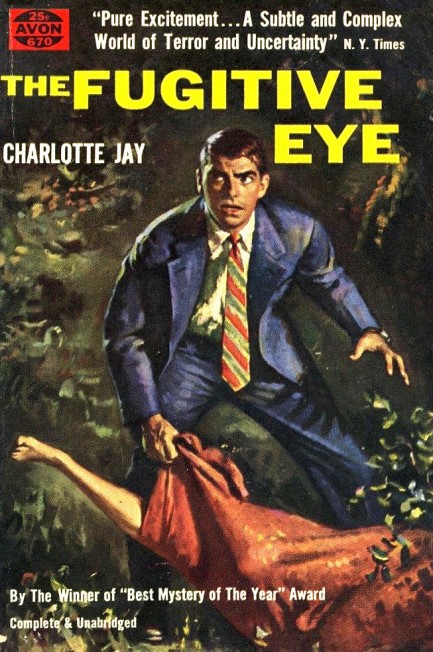
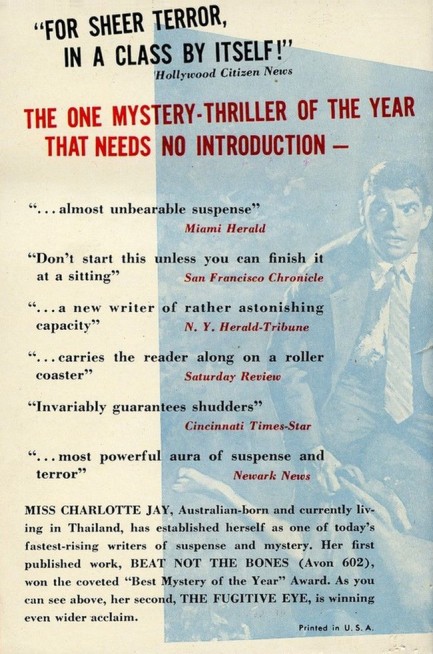
Above, both sides of Australian writer Charlotte Jay's, aka Geraldine Halls' The Fugitive Eye, for Avon Books, 1953, about a witness to murder who loses his eyesight in an accident and finds himself pursued by bad guys. The rear cover, with its multi-angle text, is almost as interesting as the front, but the art is uncredited. If you're wondering where the dead woman's other foot is, someone found it over here.
| Vintage Pulp | Aug 27 2011 |

For the last time! I gave all my spare change to the guy who pretends he's a statue!
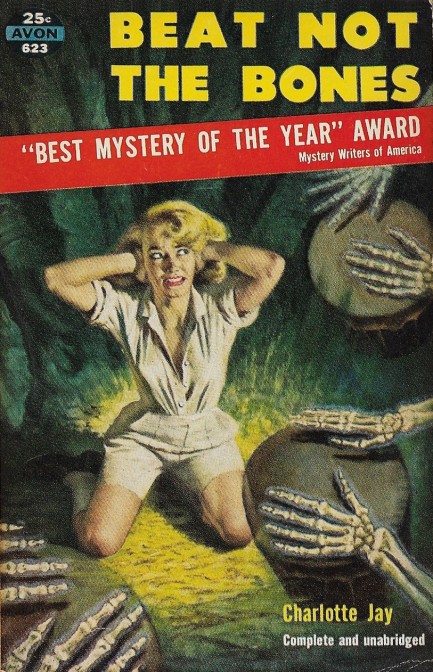
Drum circles always end up sounding exactly the same. And we say that with respect, since both of us here at Pulp Intl. are what you'd call professional drummers. No joke. It's sort of how we met. During that auspicious encounter BB said to me, “Other drummers hate me.” Me: “Why is that?” BB: “Because I'm better than them.” True story. Charlotte Jay's thriller Beat Not the Bones marches to the beat of a different drummer. The novel, which first appeared in 1952 and in the above Avon paperback edition in 1955, involves a sheltered Australian woman who ventures to the fictional New Guinean town of Marapai to prove her husband, who worked there as a government anthropologist, was a murder victim rather than a suicide. The book was well received and won Jay, aka Geraldine Halls, the inaugural Edgar Award for best mystery novel of the year.
Our expectations, in that case, were high. But were they perhaps a bit too high? Jay's prose is evocative and the setting is fascinating, but the heroine of Beat Not the Bones, tender young Emma Warwick, tries the patience just a little as she sort of gasps, swoons, and palpitates her way toward the answer she seeks. Was her husband murdered because he refused to approve the application for a gold claim? Is there a more sinister plot afoot? She can only know by embarking on a journey to the country's steamy interior. This trip into the heart of darkness, the dramatic crux of the book, doesn't begin until more than three quarters of the way through. But we knew it was imminent, and that made us impatient. Just get to the jungle journey! Beat not the bones! Get to trekkin' already! Well, Emma gets there eventually.
As she draws closer to the center of the mystery she grows emotionally stronger, hindered by some and helped by others, particularly a local acquaintance named Hitolo who works for the state but still has jungle roots. This is the type of novel where grown Papuan men like Hitolo are all “boy,” rampaging predatory colonialism is “opening up the country,” and colonials are under the delusion that their presence is helpful to the locals. But Jay, the omniscient voice of the narrator, makes clear that none of these beliefs are true. While the question among the characters is whether the very environment corrupts white men, the suggestion made by the author is that the corruption is not found there, but brought there, stowed away in the colonials' own souls.
To put a finer point on it, what truly corrupts colonials is the blatantly evil act of stealing native people's past by destroying their traditions and beliefs, and also stealing their future by taking possession of everything that holds value in the modern world that awaits them. In the face of such a robbery that leaves its victims doubly impoverished all justifications are hollow; they're a farce, winkingly acted out as cover for a greedy rampage. But we anthropologize. The jungle journey is the key to this book, and whether you like it depends on whether you consider that section worth the wait. Like your average drum circle Beat Not the Bones could have been more varied, more streamlined, more nimble, but when the end comes it's with a thunderous crescendo and a sense of waking from a dream.
To put a finer point on it, what truly corrupts colonials is the blatantly evil act of stealing native people's past by destroying their traditions and beliefs, and also stealing their future by taking possession of everything that holds value in the modern world that awaits them. In the face of such a robbery that leaves its victims doubly impoverished all justifications are hollow; they're a farce, winkingly acted out as cover for a greedy rampage. But we anthropologize. The jungle journey is the key to this book, and whether you like it depends on whether you consider that section worth the wait. Like your average drum circle Beat Not the Bones could have been more varied, more streamlined, more nimble, but when the end comes it's with a thunderous crescendo and a sense of waking from a dream.
